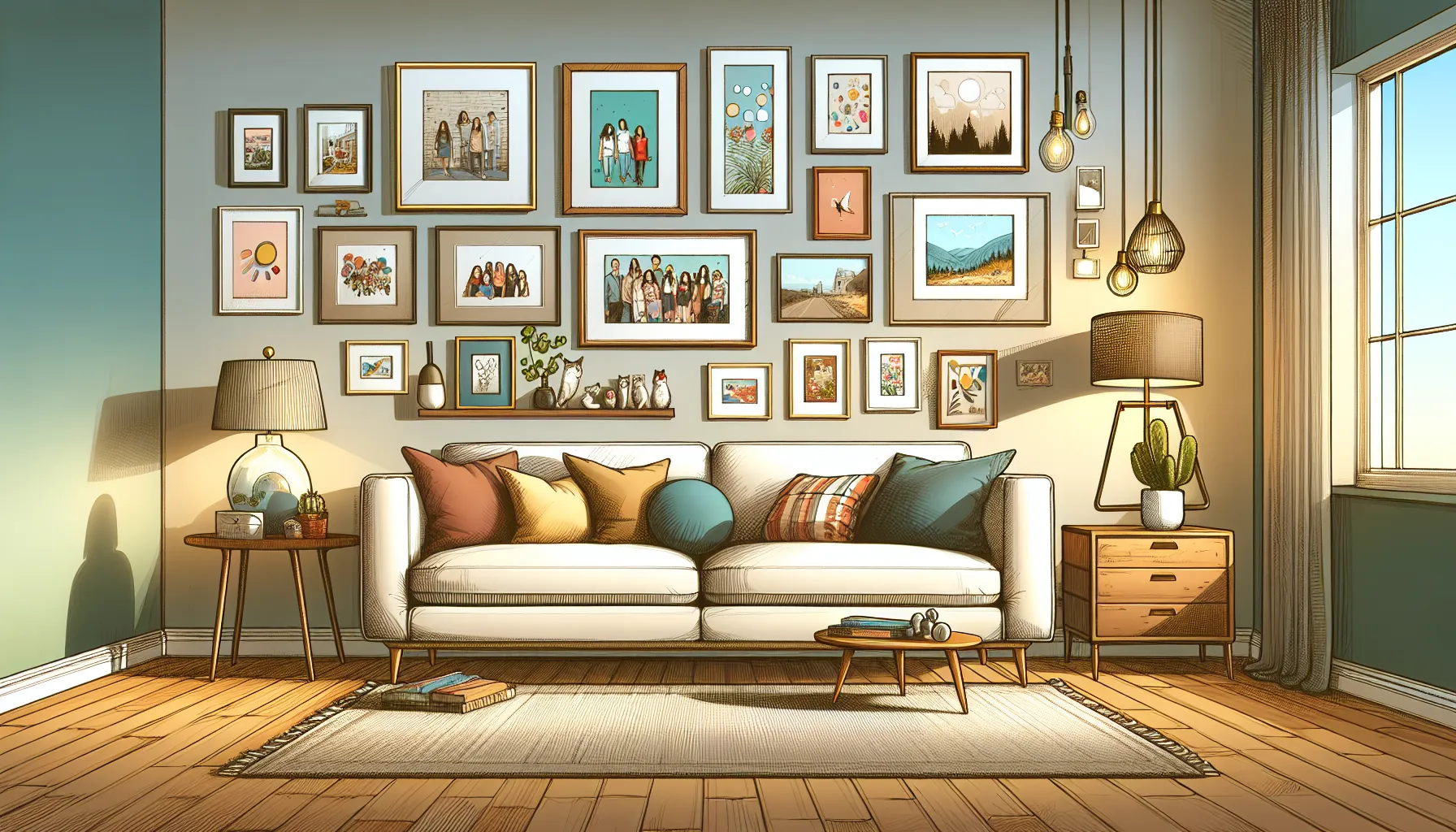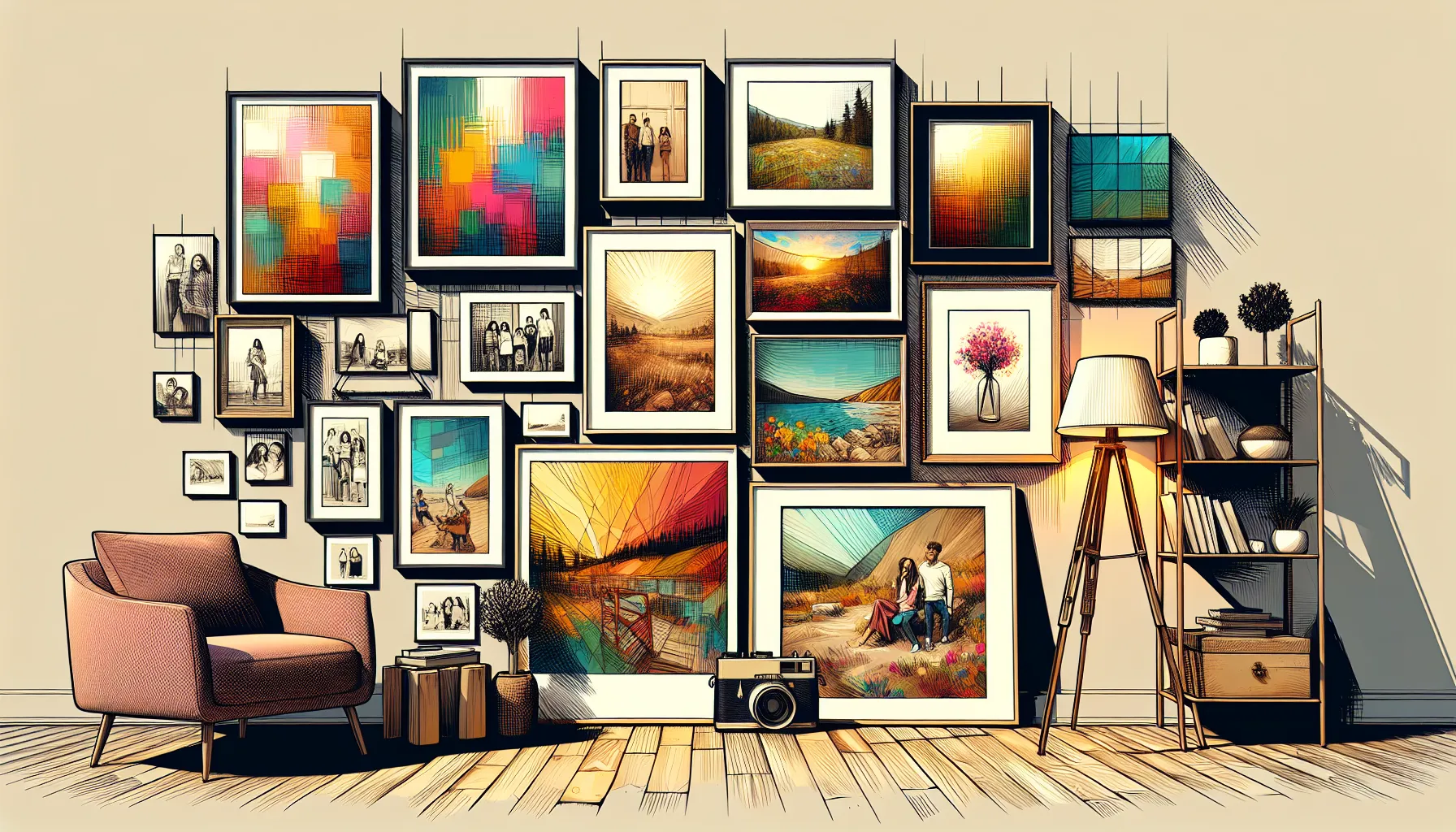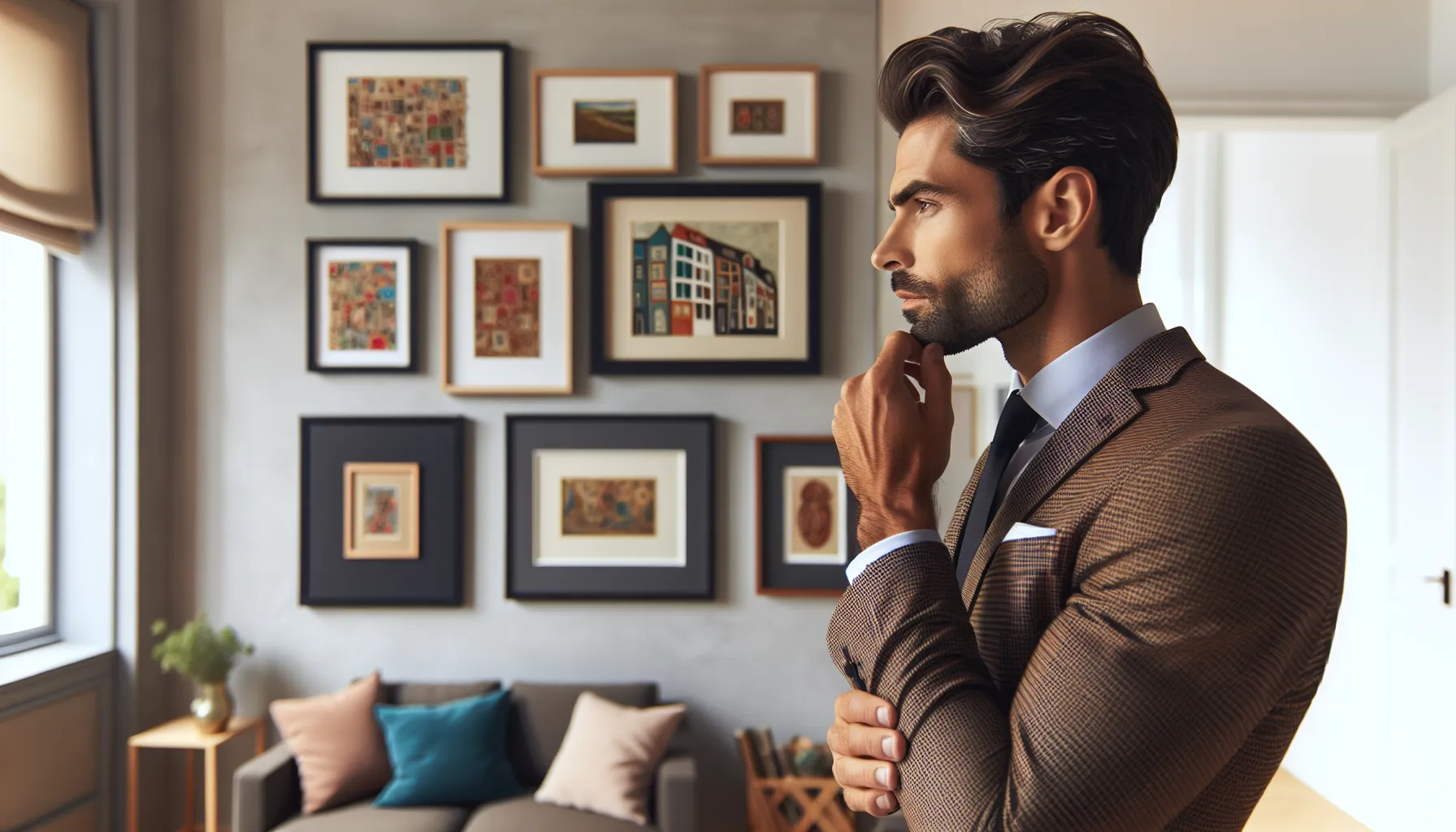Transforming a blank wall into a stunning focal point is easier than you think with gallery wall art. It’s not just about filling space; it’s about telling your story through carefully curated pieces. Whether you’re showcasing family photos, bold prints, or unique artwork, a gallery wall adds personality and charm to any room.
You don’t need to be an interior designer to create a gallery wall that wows. With the right balance of colors, frames, and layouts, you can turn an empty wall into a masterpiece. It’s all about mixing textures, playing with sizes, and letting your creativity shine. Ready to elevate your space? Let’s dive into how you can create a gallery wall that reflects your style and makes every glance feel inspiring.
What Is Gallery Wall Art?
Gallery wall art is a curated arrangement of artworks, photographs, or decorative items displayed on a wall to create a cohesive visual narrative. It combines various elements such as framed prints, canvases, mirrors, or collected memorabilia to reflect your personal style and aesthetic.
The focus of a gallery wall is visual harmony. This is achieved by carefully selecting pieces with complementary colors, themes, or designs. For example, blending black-and-white photographs with colorful abstract prints can add dimension while maintaining balance.
There are no rigid rules for gallery wall layouts. A symmetrical grid works well for a structured look, while an asymmetrical arrangement creates a more dynamic, eclectic vibe. The spacing between pieces also influences the overall effect, with closer placements producing a unified composition and wider gaps emphasizing individual elements.
Each gallery wall art design serves as a statement. Whether highlighting family memories, showcasing modern art, or incorporating vintage finds, every wall tells a unique story reflective of your personality and taste.
Benefits Of Gallery Wall Art

Gallery wall art offers multiple advantages that go beyond simple decoration. Its versatility enables you to elevate spaces while making them uniquely yours.
Enhances Home Aesthetics
Gallery wall art instantly upgrades the look of your home. By incorporating thoughtfully selected pieces, you can transform plain walls into visually appealing focal points. Coordinating colors, matching frames, and varying art sizes create a balanced and polished appearance. A well-designed gallery wall blends seamlessly with any interior style, from minimalist to eclectic.
Expresses Personal Style
A gallery wall serves as a canvas for showcasing your individuality. You can combine family photographs, art prints, or mementos to highlight your personal story. Choose themes, hues, or designs that resonate with your preferences to create a cohesive yet distinct presentation. This personalized touch makes your space feel inviting and reflective of your tastes.
Creates Visual Interest
Gallery wall art adds layers of texture and dimension to your walls. Arranging items in a mix of shapes and sizes captures attention and keeps the eye engaged. Whether featuring symmetrical grids or bold, asymmetrical layouts, the placement ensures a captivating visual flow. Incorporating contrasting elements, like abstract prints next to vintage photos, adds depth and variety, making your walls dynamic and engaging.
Choosing The Right Gallery Wall Art

Careful selection of gallery wall art defines the tone and character of your space. Focus on themes, frames, colors, and textures to achieve a visually cohesive and appealing display.
Selecting A Theme
Choosing a theme establishes a unified narrative for your gallery wall. Select a concept like family memories, nature, abstract art, or travel photography. Stick to this theme to maintain consistency. For example, a travel-inspired gallery could feature cityscapes, maps, and postcards. Themes guide your choices, ensuring the pieces connect stylistically and emotionally.
Mixing And Matching Frames
Diverse frame styles add depth without compromising harmony. Combine wooden, metallic, and painted frames for variety, ensuring they complement the wall’s overall aesthetic. For instance, pairing sleek black frames with rustic wooden ones creates a striking contrast. Limit frame colors to two or three shades to avoid visual clutter.
Balancing Colors And Textures
Balance colors by selecting pieces with complementary palettes. Include a mix of bright, neutral, and dark tones to create depth. For textures, opt for a combination of matte prints, glossy photos, or textiles like woven art. Ensuring contrast in textures and balance in colors helps the gallery wall remain cohesive yet dynamic. For example, pairing a vibrant abstract painting with a subdued landscape photograph introduces contrast while maintaining harmony.
Tips For Arranging Gallery Wall Art

Arranging gallery wall art effectively ensures a visually appealing and cohesive display. The right approach balances creativity with structure, enhancing any space.
Planning The Layout
Start by determining the overall shape you want your gallery wall to achieve, such as a grid, radial, or freeform style. Consider the wall size and location to define boundaries for your design. Lay out the selected pieces on the floor to experiment with arrangements while keeping balance in mind. Position larger items as anchors and surround them with smaller pieces for visual cohesion. If your collection has varying sizes, stagger them for a dynamic and harmonious look.
Proper Placement And Spacing
Hang the center of the arrangement at eye level, approximately 57-60 inches from the floor. Ensure that spacing between pieces remains uniform for a polished appearance, with gaps ranging from 1 to 3 inches depending on the display size. Avoid overcrowding by maintaining proportional space around the artwork and edges of the wall. Factor in furniture placement, ensuring that the artwork complements, rather than competes with, nearby elements.
Using Templates Or Tools
Use paper templates to map out the arrangement on the wall before hanging. Trace and cut out shapes of your frames, then tape them to the wall to visualize the layout. Mark nail placements to avoid unnecessary holes. Alternatively, consider digital tools or apps designed for gallery wall planning, which allow you to preview and refine layouts virtually. For straight lines, use a level tool or painter’s tape to guide alignment, ensuring a precise and professional-looking setup.
Popular Styles And Trends In Gallery Wall Art
Gallery wall art reflects an ever-changing landscape of styles and trends. Exploring different approaches helps you find a design that resonates with your aesthetic and complements your space.
Minimalist Designs
Minimalist gallery wall art focuses on simplicity and functionality. Choose monochromatic color schemes, black-and-white photographs, or line drawings to create a clean and uncluttered look. Opt for frames with thin borders or go frameless to maintain the minimalist intent. Uniform spacing and geometric layouts, such as grids or straight lines, enhance the style’s structured appeal, making it perfect for modern interiors.
Eclectic Compositions
Eclectic designs bring together diverse elements for a lively, curated look. Combine vintage paintings, bold abstract prints, and textured objects, like woven pieces or mirrors, for contrast. Use overlapping frames, mixed frame styles, and irregular spacing to embrace a less structured layout. This approach works well for showcasing a wide range of personal artifacts and collected items while still making an impactful statement.
Seasonal Themes
Seasonal gallery wall trends align with the changing times of the year. Incorporate vibrant floral prints in spring or warm-toned landscapes during fall. Select artworks and decorative pieces, such as wreaths or seasonal typography, that reflect holidays or special occasions for added charm. Rotating pieces seasonally helps keep your gallery wall fresh and engaging, adapting your decor to the mood of the moment.
Where To Buy Gallery Wall Art
Finding the right gallery wall art elevates your space and reflects your unique style. Explore different options to discover pieces that align with your vision.
Local Art Stores
Visit local art stores for original and diverse wall art. These stores often feature works by regional artists, giving you access to one-of-a-kind pieces. Check community art galleries and craft markets for framed paintings, prints, or photographs. Many stores also offer custom framing, ensuring your gallery wall has a cohesive finish.
Online Marketplaces
Browse online marketplaces for convenience and variety. Platforms like Etsy, Society6, and Redbubble offer custom-made prints, photography, and unique designs from independent creators. Websites like Wayfair and West Elm provide curated options, ideal for those seeking polished collections. Use filters to search by color, size, and style to streamline your selection.
DIY Options
Create personalized gallery art for a meaningful touch. Print high-quality photos, design custom typography, or repurpose vintage illustrations. Use crafting supplies from specialty shops like Michaels or Hobby Lobby to add decorative elements. This approach lets you tailor every piece to your gallery wall’s theme and style.
Conclusion
Gallery wall art offers a unique opportunity to infuse your space with personality and creativity. By thoughtfully curating pieces that reflect your style and arranging them with care, you can transform any blank wall into a stunning focal point. Whether you prefer a minimalist vibe or an eclectic mix, the possibilities are endless.
Take your time exploring art that resonates with you, experimenting with layouts, and balancing colors and textures. With a little planning and imagination, your gallery wall can become a true reflection of your story and a source of inspiration every day.
Frequently Asked Questions
What is a gallery wall?
A gallery wall is a curated arrangement of artwork, photographs, or decorative items displayed on a wall to create a cohesive visual narrative. It combines various art pieces, frame styles, and textures to reflect personal taste and add character to a space.
How do I start planning a gallery wall?
Begin by choosing a theme, such as family photos, travel memories, or abstract art. Then, gather pieces that match the theme. Plan the layout on the floor or use templates to visualize the arrangement before hanging anything on the wall.
What is the best layout for a gallery wall?
There’s no one-size-fits-all layout. Symmetrical grids provide a clean, structured look, while asymmetrical or freeform designs create a dynamic and creative vibe. Choose one that suits your style and available space.
How can I achieve balance in my gallery wall?
To achieve balance, mix frame styles and sizes but limit the colors to two or three. Use complementary color schemes and textures to create harmony and avoid visual clutter.
What height should a gallery wall be hung?
The center of the gallery wall should typically be at eye level, approximately 57–60 inches from the floor. Adjust for room and furniture height to ensure the arrangement feels natural.
Can I mix frame styles and sizes on a gallery wall?
Yes, mixing frames adds visual interest. Use a mix of sizes for dimension and choose up to three complementary frame colors to maintain cohesion while preventing a cluttered look.
What type of art works best for a gallery wall?
A variety of pieces work well, including family photographs, art prints, paintings, or even personal mementos. Select items that resonate emotionally or fit your chosen theme for a curated, personal touch.
How do I choose the right spacing between pieces?
Spacing depends on the size of the wall and artwork. As a general guideline, keep 2–3 inches between small frames and 4–6 inches for larger pieces. Consistent spacing ensures a polished appearance.
What are some popular styles for gallery walls?
Popular styles include minimalist designs featuring monochromatic tones and clean lines, eclectic arrangements combining diverse elements, and seasonal themes showcasing artworks that reflect different times of the year.
Where can I find art for my gallery wall?
You can find art at local galleries, online marketplaces, or print shops. DIY options, like creating your own artwork or framing sentimental items, are great for adding a personal touch.
How do I keep my gallery wall visually cohesive?
Stick to a unified theme, use similar frame styles or colors, and balance textures and colors. Complementary hues and a mix of matte and glossy finishes add depth while maintaining harmony.
Can I include non-art elements in my gallery wall?
Yes! Incorporating mirrors, clocks, or decorative pieces alongside art creates a dynamic and visually engaging display that feels unique and personal.

Leave a Reply